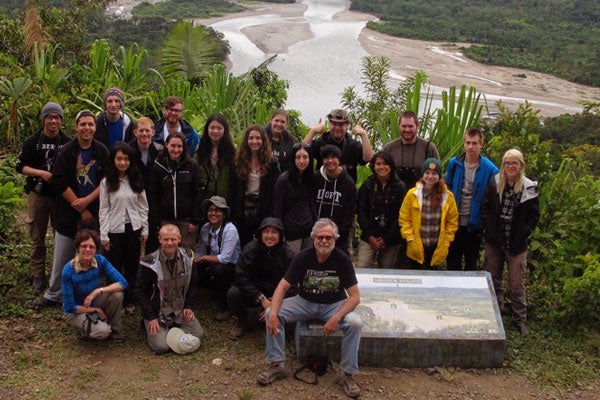
From the Andes to the Amazon: U of T students in "biodiversity hotspot"
Published: September 2, 2014
Danielle de Carle was terrified. The University of Toronto ecology and evolutionary biology student was alone in the Peruvian rain forest – for once without a headlamp – with monkeys, birds and insects creating a cacophony of noise around her.
But despite her fear that night, she was thrilled to be in Peru, taking part in U of T’s two-week Tropical Field Biology course this past summer. The fourth-year course took de Carle, two professors and 19 other students on a two-week journey from Toronto to the Wayqecha Cloud Forest Research Center in the Andes Mountains and then down to the Los Amigos Research Center along a tributary of the Amazon River. (See a photo gallery of the expedition.)
The course has been offered in one form or another for about 20 years, according to Associate Professor Chris Darling. The U of T entomologist and Royal Ontario Museum curator taught the course along with U of T botanist Spencer Barrett, who holds the title of University Professor, the highest distinction U of T bestows on faculty members. (Read more about University Professors at U of T.)
Previously offered in Ecuador, Costa Rica, Panama and Guatemala, the course has taken place in Peru during recent years.The country provides an ideal location, Darling said.
“It’s one of the biodiversity hotspots of the world, with more animals and plant species in this particular area than in most other places,” said Darling.
Another advantage: the change in elevation from the Andes down to the Amazon is a transition that allows the class to explore how plant and animal communities change as the altitude decreases.
The altitudinal change did present some problems, he said. “Some people had headaches associated with the low levels of oxygen in the air at high altitude. It takes a couple of days to get over it – you can’t be too strenuous at high elevation sites.”
But the adjustment is worth it, Darling said. “The students get to study the interactions of plants and animals and the incredible richness of Peru. It’s a great opportunity to expose them to field biology because much of their learning up to this time has been from textbooks, from the internet and from academic papers.”
And students get to learn in relative comfort. De Carle was pleasantly surprised to find that, contrary to her expectations, she didn’t have to sleep in a tent and cook her own food. “We stayed at field stations where we were able to focus on the course because we weren't cooking and camping and we had a warm, dry place to sleep.”
Not having to cook or pitch a tent allowed de Carle more time to study dung beetles. She wanted to figure out how the dung beetle communities varied in different areas of disturbed habitat.
"Dung beetles (image below right) rely on larger vertebrates for their food sources, and people have been exploring the idea of using them as indicators for biodiversity at large.”
their food sources, and people have been exploring the idea of using them as indicators for biodiversity at large.”
Darling said travel was the biggest challenge. “The easiest part was getting from Toronto to Lima, Peru by Air Canada. From Lima we took another flight to Cuzco, and from there it was small vans down to the lowlands and then onto boats for a two-day ride to the field station on the Alto Madre de Dios River.”
Darling was glad of the opportunity to co-teach the course. “Being able to take upper-level undergraduates as a group off into the wilds is really quite exciting, because of the potential for new discoveries.
“On one field course we once discovered a caterpillar that jumps – it was a very cool, completely undiscovered thing, and it came about from a field course. It’s a result of being in the field with time on your hands looking around and seeing what’s there. You never know what you’re going to see.”
Terry Lavender writes about global and international issues for U of T News.



